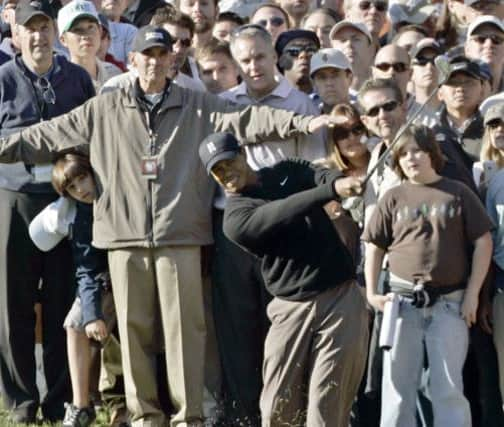Naked eye not TV to decide if golf ball ‘moves’


After an 18-month review of the role being played by the game’s “armchair police”, the R&A and USGA, the game’s two governing bodies, have decided that, from 1 January, players will not be penalised under the Rules of Golf if their ball moves and it wasn’t obvious to the naked eye.
No longer will television evidence, which can in volve pictures being significantly slowed down and a golf ball blown up to the size of a basketball on the screen, be the sole tool used to punish players when a ball is moved inadvertently.
Advertisement
Hide AdAdvertisement
Hide AdWhile the R&A and USGA have no problem with TV viewers reporting incidents such as the illegal drop taken by Tiger Woods in this year’s Masters, they say it is unfair that players can be made to look like clear culprits by technology when they themselves may not necessarily feel they’ve done anything.
Woods, for instance, was hit with two penalty strokes in the second round of the BMW Championship during this year’s FedEx Cup Play-Offs. The world No 1 moved a twig near his ball and video evidence later showed the ball moving.
Woods claimed it had merely oscillated, but that infringement incurred a one-stroke penalty. He was docked another stroke because the ball was not returned to its original position.
David Rickman, the R&A’s Executive Director – Rules and Equipment Standards, insisted the joint review had been concluded prior to that incident but acknowledged it highlighted a “live issue” and one that is now being dealt with in the latest two-yearly “Decisions on the Rules of Golf” review.
“New Decision 18/4,” revealed the R&A and USGA in a joint statement, “provides that, where enhanced technological evidence (eg HDTV, digital recording or online visual media, etc.) shows that a ball has left its position and come to rest in another location, the ball will not be deemed to have moved if that movement was not reasonably discernible to the naked eye at the time.”
Reaction to the decision included former Open Championship press officer David Begg, branding it a “dangerous development” on Twitter. “If it moved, it moved,” he wrote using the hashtag #cheatscharter.
However, the governing bodies believe it is both a correct and sensible step. It comes on the back of a retrospective penalty being introduced instead of instant disqualification for unwittingly signing for a wrong score, a decision taken following an incident involving Padraig Harrington in Abu Dhabi in 2011.
Rickman said: “We have been working on TV evidence for about 18 months and our review drew to a conclusion in late summer. We believe that the use of TV evidence in general is both positive and appropriate for the game. It is important for its integrity, though, that we decide matters on the facts of cases and reach the right answer. Golf has a long history of players taking a penalty because a ball has moved but, equally, there are a number of situations where a player could potentially be penalised due to the movement being so small that it is hard to tell if there was indeed any movement.
Advertisement
Hide AdAdvertisement
Hide Ad“Hence the introduction of what we are calling the ‘naked eye approach’. It will be up to the committee to decide if an incident was discernible to the naked eye and, if not, the TV evidence will be disregarded.”
Fifer Peter Whiteford fell foul of the old approach when he was in contention for his maiden European Tour triumph in the 2012 Avantha Masters in India. One off the lead as he teed off for his fourth round, he’d asked those close to the scene for their opinions on whether the ball had moved as he played his approach to the 18th. They didn’t think it had, so he signed his scorecard. Overnight, “several viewers” contacted the European Tour to say that Whiteford’s ball had moved. A review by the Rules Committee determined that he should have incurred a one-stroke penalty and replaced the ball, so he was disqualified for signing for the wrong score.
The Scotsman understands the new decision would not alter the outcome of Whiteford’s case as he had initially questioned whether the ball moved so it could be concluded that it had been discernible to the naked eye.
“It is important to determine the facts and we believe this will redirect the balance,” added Rickman. “We appreciate this is not going to be easy.”
Other changes include players being allowed to get smartphone weather reports during a round and being allowed to go forward 50 yards without forfeiting the right to go back and play a provisional ball.
“We’ve probably been guilty of letting the number of Decisions grow in recent years and withdrawing 24 while adding three at the same time is a small move in the right direction in terms of size,” added Rickman.